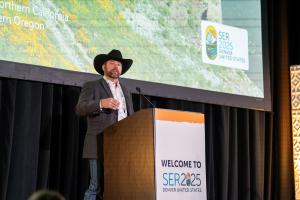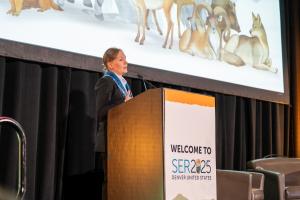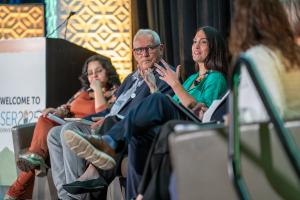Delegates at SER2025 Issue Call to Action Urging Mobilization of Ecological Restoration Worldwide

David Coffman, RES’ Director of Northern California and Southern Oregon Operations, speaking at SER2025 about Lessons Learned from the World’s Largest Salmon Restoration Effort.
Healthy freshwater systems support healthy life on land
“Freshwater Ecosystems are the living arteries of our landscapes,” said Christine Colvin, Policy Lead for Freshwater at WWF International. “Policies are increasingly recognizing the synergistic role of freshwater systems to meet the major challenges that we face today: climate change, biodiversity loss, and land degradation.”
Few projects demonstrate these synergies on the scale of the Klamath River dam removal. This vast project restored the flow of the river, regenerated landscapes, and brought back thriving habitats. In addition, it had a “direct and positive impact” on the Hupa and Yurok people, who have lived alongside the river for generations. “We all know without a doubt that ecological restoration benefits the environment, the fish, the bugs. We can all agree that a fish needs water, but what about the people who need fish?” Asked Dave Coffman, Klamath River Renewal Project Restoration Program Manager.
Building technology and capacity to scale terrestrial restoration
Kazakhstan's saiga antelope population rebounded from 21,000 to nearly 3 million in two decades through the globally recognized Altyn Dala Conservation Initiative. Vera Voronova, Chair of the initiative and Executive Director of the Association for the Conservation of Biodiversity of Kazakhstan, discussed the challenges of a project that spans more than 75,000 hectares and affects a multitude of communities across the landscape.
“Kazakhstan is a small country, and one of the biggest challenges of a project of this scale is the lack of experts to do the work. To build capacity, we have developed a program called Students for Nature, where we pick talented students and give them a chance to engage with our work,” said Ms. Voronova, herself an alumnus of the program. Altyn Dala is also testing innovations in project implementation and monitoring at scale, including the use of drones and other automated tools to collect and analyze data. The Altyn Dala program provides a valuable model of effective approaches for moving from commitment to action.
Science, logistics, and stubborn love in coral reef restoration
With global coral reefs repeatedly suffering from mass bleaching and record-breaking ocean temperatures, Dr. Phanor Montoya-Maya, restoration program manager at the Coral Reef Restoration Foundation in Florida, asked the question many in the ecological restoration community have been asking themselves: why bother? Small wins like the discovery of corals adapting to changing conditions provided rich seams for research into increasing reef resilience using standards-based approaches to implement and measure projects. And a global community of people - the Coral Restoration Consortium - willing to take action offered inspiration and hope.
“Over three decades, I have learned that reef restoration is equal parts science, logistics, and stubborn love. Science tells us what to try next, the logistics lets us do it to scale, and love makes us go back after a hard lesson and do it better….even in the darkest conditions, nature can surprise us,” said Dr. Montoya.
Translating commitments into real work actions
The conference’s high-level panel brought together leaders from global intergovernmental organizations, NGOs, and Indigenous communities, alongside experts from the government and corporate sectors, to discuss the enabling conditions needed to accelerate restoration in the second half of the UN Decade on Ecosystem Restoration. Panelists offered insights and diverse perspectives on the need for collaboration, capacity-building, supportive policies, and innovative funding to scale restoration.
Christophe Besacier, Senior Forestry Officer at the UN Food and Agriculture Organisation (FAO) emphasized the importance of innovative and sustained finance. “Another way to overcome barriers is to mobilize adequate financial resources to design, implement, and monitor large-scale ecosystem restoration initiatives…we need to raise awareness of the benefits of ecosystem restoration…and showcase the economic returns of what we are doing.”
Corporations increasingly understand the benefits of restoration, and Mars, Inc. has been a leader in investing in restoration to increase supply chain resilience. Maia Reed, Global Climate Data Lead at Mars Petcare, shared the company’s commitment to being a sustainable corporation within a generation, pointing out the need to be proactive. “Doing less harm is not the same as doing more good,” she said.
In her closing remarks at the conference, SER’s Executive Director, Bethanie Walder, called for peace, trust, reciprocity, and community. Appreciating the ambition, but raising the concern that we may not be on track to meet the UN Decade on Ecosystem Restoration and the Kunming-Montreal Global Biodiversity Framework target to bring 30% of degraded lands and waters under effective restoration by 2030, she answered Montoya-Maya’s question: “We must bother. Ambition and commitments are not enough. We need urgent action now. Restoration is becoming a global movement, but we need more; we need a restoration revolution.”
“SER2025 marks a pivotal moment in the UN Decade on Ecosystem Restoration and the Kunming-Montreal Global Biodiversity Framework, which urge countries to bring 30% of degraded lands and waters under effective restoration by 2030. These commitments are inspiring and ambitious, but ambition is not enough. We need urgent action now. Restoration is becoming a global movement, but we need more than that, we need a restoration revolution.”
Rewatch the SER2025 Live Stream of the Plenaries and Closing Ceremony.
Florencia Panizza
Claro Communications Consulting
florencia@claro-comm.com
Legal Disclaimer:
EIN Presswire provides this news content "as is" without warranty of any kind. We do not accept any responsibility or liability for the accuracy, content, images, videos, licenses, completeness, legality, or reliability of the information contained in this article. If you have any complaints or copyright issues related to this article, kindly contact the author above.


